COVID-19 Lessons for a More Resilient Future
“Since 2002, the U.S. has endured seven of the 10 most costly disasters in its history, with Hurricane Katrina and Superstorm Sandy topping the list. As a result, there is a need for best practices for resilience planning that address the increasing value-at-risk of U.S. infrastructure and communities. Communities, as a system, are particularly vulnerable to the effects of natural and human-caused disruptive events. Reliance on rebuild-as-before strategies is impractical and inefficient when dealing with persistent hazards. Instead, communities must break the cycle by enhancing their resilience with a systemic view of short- and long-run time horizons.”
NIST Special Publication 1197 – Community Resilience Economic Decision Guide for Buildings and Infrastructure Systems
The Federal Emergency Management Agency (FEMA) and, by extension, the architectural engineering profession have embraced the four-phase disaster management cycle as a framework for improving community resilience through capacity building (Figure 1). If cities heed all phases of the disaster management cycle by directing funds or resources to each phase, the presumption is that they will be better able to tolerate and recover from future natural and human-caused disasters. Unfortunately, the COVID-19 pandemic represents a natural disaster that has stress-tested the disaster management cycle. We have witnessed profound political, social, and economic disruptions associated with the constant vacillation between the response and the recovery phase as society struggles to “flatten the curve” and manage infection rates across the county. In this article (first in a series), we contemplate the suitability of the disaster management cycle as a framework to define and enhance community resilience to disasters. In response to society’s adaptation to a moving recovery target, we consider an alternative disaster management cycle that reflects lessons learned during the COVID-19 pandemic and discuss its application to natural hazards. We introduce the concept of adaptive resilience: the ability to implement immediate changes that minimize the impact of disruptive forces associated with a disaster while working to transform the built environment, real-time, using systems thinking. We also discuss the critical role of a structural engineer in applying advocacy, education, and transformative design solutions to the built environment to enhance community resilience.
Re-Thinking the Disaster Management Cycle
Corona Virus Disease 2019 (COVID-19) caused by SARS-CoV-2, a novel (i.e., not previously identified) coronavirus, emerged in December 2019 in Wuhan City, Hubei Province, China. By January 30, 2020, the World Health Organization declared the COVID-19 epidemic an international public health emergency. The scope and magnitude of this crisis have exacerbated systemic inequities, disrupted global supply chains, burdened local healthcare capacity, and significantly changed human life and livelihood. How society is applying disaster management techniques in response to this crisis provides ample opportunity to explore ways to improve crisis management for future disasters.
FEMA’s Four Phases of Emergency Management (FEMA 2006), otherwise referred to as the disaster management cycle, includes: preparation, response, recovery, and mitigation. These phases are defined as:
- Preparation: Activities undertaken in advance of an emergency to develop and enhance operational capacity to respond to and recover from an emergency.
- Response: Activities conducted to save lives and prevent harm to people and property during an emergency.
- Recovery: A return to normalcy after a disaster or emergency incident.
- Mitigation: Any sustained action taken to reduce or eliminate long-term risk to people and property from natural or human-caused hazards and their effects.
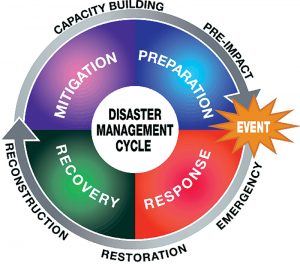
The graphic representation of the cycle presented in Figure 1 proportions each phase in the cycle for illustrative purposes only; actual phase duration/effort may vary relative to others. For example, extensive mitigation and preparation guided by community performance goals would limit response and recovery phases.
During the COVID-19 pandemic, we have observed a transition from the response to the recovery phase during a pandemic is unlike the transitions for other natural hazards (earthquake, hurricane, landslide, etc.). Most natural disasters last for a finite time before the immediate threat dissipates (e.g., the storm passes, the ground stops shaking, the floodwaters recede, and the fires are contained). Once the disaster is contained and the damage is triaged, the community can transition from response to recovery. This process is challenged by the COVID-19 pandemic, where society oscillates between recovery and response over an extended period. This creates an opportunity to define and deploy a new phase into the FEMA cycle.
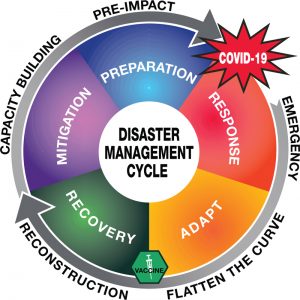
The cycle associated with the COVID-19 pandemic more closely aligns with the cycle shown in Figure 2, where an additional phase, adapt, occurs between response and recovery. The adapt phase covers the period of prolonged duress, where localities are in a hyper-situational state of awareness and are attempting to slow continued damage and “flatten the curve.” At the same time, recovery efforts adjust to help approach an “end” to the event cycle so that mitigation can start anew. For the COVID-19 pandemic, the adapt phase aligns with continual management of restrictions and messaging until the vaccine can instigate a broader herd immunity so that schools, restaurants, etc., can safely open and “normal” activities can resume, in some cases at pre-event levels.
The adapt phase also has application to disaster management for natural hazards. After an earthquake or hurricane, for example, it is feasible that affected populations will live in temporary structures while their homes are being rebuilt, but the primary threat has been significantly reduced. This is a clear transition from the response phase to the recovery phase, with a relatively short adapt phase. For the COVID-19 pandemic, society is caught between phases when infection rates fluctuate. As soon as a city assumes transition to recovery, businesses open back up and individuals relax their attention to recommended precautions. As a result, the cases go up and force the community back into a response phase. Arguably, during COVID-19, the recovery phase is only possible post-vaccine/herd immunity, effective when the threat is significantly diminished. The reference to recovery, in this case, assumes a return to normal, which is not possible without a vaccine, herd immunity, or protectionist policies (closing borders to goods, services, restricted travel, etc.).
Figure 2 is limited since the insinuation that society cannot advance to recovery unless a vaccine is widely distributed is not realistic with regards to the concept of adaptive resilience. While we have vaccines for the COVID-19 virus, what about the next pandemic? We want to imagine a disaster management cycle that applies to all disasters, including health-related disasters that were previously not considered so widely spread and debilitating.
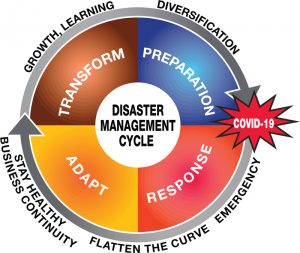
With this in mind, we want the resilience planning community to consider an alternative framework for disaster management. This alternative framework takes the vaccine (or guaranteed end of the disaster) out of the equation and actively manages the recovery process through resilience planning and design. Figure 3, the alternative disaster management cycle, accomplishes three primary objectives:
- Replaces the recovery phase with an adapt phase. This recharacterization of the post-disaster phase strives to take a future-focused approach to recovery. The term recovery insinuates a return to normal aligned with the pre-disaster state. In some cases, the pre-disaster state could leave the community vulnerable to future hazards until the mitigation phase is complete. We want to shift the recovery goals to focus on both short-term and long-term time horizons. COVID-19 and natural disasters have similarly indicated that a return to “normal” is not good enough (Hurricane Katrina is an exemplary natural hazard for this statement). Adaptation encourages innovative ways to consider new targets for functionality and how best to construct societal infrastructure to achieve satisfactory results. The authors recognize that “building back better” may have traditionally fit that paradigm. Still, in many cases, that approach increases recovery time, which may undermine societal needs or desires to recover as quickly as possible. Ideally, the preparation phase includes strategies that consider adaptation scenarios post-disaster, thereby minimizing the recovery time following an event.
- Replaces the mitigate phase with a transformation phase. The term mitigate insinuates risk reduction for the subject disaster. The term itself assumes that existing operational standards (e.g., building codes) are adequate. While this approach works well for known hazards and low-level recovery targets, it does not address new hazards or changing paradigms associated with a range of recovery targets that are acceptable to an affected community. Transformation intends to broaden the goal of disaster management beyond mitigation into strategies that include deployment of new technologies, resilience-focused planning that considers diversification of critical infrastructure in terms of power sources, utility transmission, reconstruction strategies beyond “rebuild in place.” This may also include deploying innovative solutions that are implemented or enforced before a disaster occurs.
- Considering the goal of Resilience itself. A critical evaluation of the disaster management cycle, as it relates to the built infrastructure, illuminates a need for the building industry and policymakers responsible for the built infrastructure to shift disaster management and planning toward a future-focused target that actually considers a constantly changing environment. While adaptation is inherently included in the definition of resilience, the distinction between resilience and adaptive resilience lies in the definition of the recovery goal. Adaptive resilience is future-focused and implores an evolution or iteration of the practitioners’ approach, considering all conditions and applying systems-thinking to determine the best target that considers societal expectations and needs while avoiding “replacement in-kind” thinking. The concept of adaptive resilience represents the ability to implement immediate and future changes that minimize impacts of disruptive forces, whether from a pandemic or a natural disaster, in short-term and long-term time horizons.
Ultimately, Figure 3 recalls the roots of resilience theory – the idea that true resilience is observed in the ecological context. Biodiversity (or, in this case, diversity of physical, economic, social systems) enhances the community’s ability to return to an acceptable quality of life while growing, learning, and applying new technologies and the changes they bring. Evolution (i.e., adaption) ensures the survivability of the species.
What This Means for the Structural Engineer
There are different general definitions of resilience depending on perspective (ecological, psychological, disaster management, engineered) and scale (individual, institutional, community, local, regional). Some widely accepted definitions of resilience, like that developed by the National Academy of Sciences, focus on “the ability to prepare and plan for, absorb, recover from, and more successfully adapt to adverse events” (NRC 2012). Practicing structural engineers play a vital role in making communities more resilient through the design and construction of the built environment using recovery-based performance objectives. Resilience is dependent on and inherent to communities rather than individual buildings. It is focused on community functionality, which requires operational infrastructure and building space rather than just protection of built space. It is measured over time rather than in terms of property damage (Bonowitz, 2020 EERI Distinguished Lecture). The concept is eloquently described in the FEMA/NIST functional recovery report (FEMA P-2090/NIST SP-1254):
“…we don’t just want to preserve life, but we want to preserve quality of life”.
In addition to reevaluating how we design buildings, structural engineers need to embrace the multi-disciplinary aspects of community resilience. Many strategies described in this article require input and implementation by other stakeholders (e.g., policymakers, the public, planners, emergency responders, architects). True resilience can only be achieved through a cross-disciplinary, collaborative, community-focused approach.
There are two ways that structural engineers can affect community resilience: 1) structural engineer as an advocate and educator, and 2) structural engineer as a transformative thinker.
Structural Engineer as an Advocate and Educator
A structural engineer is typically focused on designing a building to meet their client’s needs and ensuring the design meets the requirements of the building code. As a result, most owners do not participate in defining building performance objectives in various natural hazards but default to the building code, assuming it will provide adequate performance. Unfortunately, many building owners and members of the public do not understand that the building code is focused on minimizing loss of life and does not consider post-disaster recovery.
Structural engineers should discuss post-event performance with their clients and include them in the design process so that they understand that a code-compliant building will be safe but may not be habitable following a natural disaster. These discussions should include real scenario examples that incorporate business interruption costs and recovery costs associated with the loss of building functionality following a natural disaster. Some improvement in post-disaster business recovery can come from planning to reduce downtime (i.e., business continuity plan). In addition, structural engineers can educate themselves on emerging technologies and strategies that can be included in the building design process and enhance long-term building performance in a cost-effective fashion.
Structural Engineer as a Transformative Thinker
Designing for functional recovery or other performance targets is considered a transformative approach to structural engineering design and assessment. Areas affected by Hurricane Katrina present some excellent examples of transformative thinking from which we can learn. On August 29, 2005, Hurricane Katrina made landfall in Plaquemines Parish, Louisiana. The associated winds gusted up to 115 mph, bringing a 13-foot storm surge that left a path of destruction, devastating local communities. The hurricane caused over 2,000 casualties and over $200 billion of economic losses. In addition, the school campus at Port Sulfur, Louisiana, suffered extensive hurricane damage associated with storm surge and debris impact.
Instead of “recovering” to existing (pre-hurricane) conditions, the school district adopted an adaptive reconstruction approach. Climate risk and building functionality were considered for the replacement campus. The school district recognized that the replacement campus should withstand storm surge and hurricane wind forces in future events to reduce the operational downtime post-disaster.
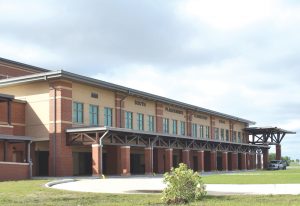
The newly completed elementary school campus in Port Sulphur includes elevated classrooms and associated facilities (Figure 4). While this was a transformative design approach for this specific location, it is a simple design philosophy that can be applied to all disasters. In the case of Plaquemines Parish, this transformative design approach was applied to critical services buildings that include a medical center (Figure 5), a community center, a high school, and teacher housing.
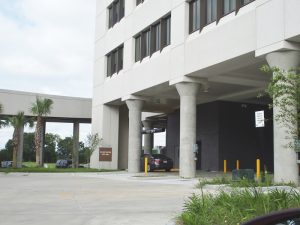
Concluding Thoughts
COVID-19 has shown us that our strength lies in our capacity for adaptive resilience. Unlike other natural disasters, the virus has affected the global community, with quality of life disrupted by process change instead of physical (infrastructural) damage. The duration of negative consequences to society is significant and prolonged because the singular event recurs and prevents a return to acceptable levels of function. Considering the broader effect on society, COVID-19 has challenged the conventional disaster management framework and illuminated the need for incorporating adaptive resilience into an effective strategy. The pandemic and its aftermath will undoubtedly shift the way we approach disaster management in the future, recognizing how these lessons will inherently promote a more human-centric, health-focused approach. This adaptive resilience approach has implications that translate to the traditional “building back better” recovery strategies. We now may consider building back differently, including techniques and methods that may transform the built environment to better accommodate societal needs following natural disasters. Follow-on articles will explore certain indicators that served as a proxy for the effects of the pandemic on the health of the economy, where one can draw parallels to disaster recovery theory and explore ways to adapt and improve resilience to a disruptive event.■
References
FEMA – Federal Emergency Management Agency. 2006. Principles of Emergency Management, Independent Study, IS230, Washington.
NRC (National Research Council). Disaster resilience: A national imperative. Washington, D.C.: The National Academies Press; 2012.
Recommended Options for Improving the Built Environment for Post-Earthquake Reoccupancy and Functional Recovery Time, FEMA P-2090/ NIST SP-1254 / January 2021.
NIST (National Institute of Standards and Technology). Special Publication 1197, Community Resilience Economic Decision Guide for Buildings and Infrastructure Systems. U.S. Department of Commerce, Washington D.C./December 2015.
